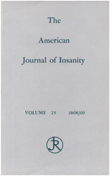A case-controlled study of repetitive thoughts and behavior in adults with autistic disorder and obsessive-compulsive disorder
Abstract
OBJECTIVE: The purpose of this study was to investigate the types of repetitive thoughts and behavior demonstrated by adults with autistic disorder and compare them with those of age- and sex-matched adults with obsessive-compulsive disorder. METHOD: Fifty consecutive patients admitted to the Yale Adult Pervasive Developmental Disorders (Autism) Clinic with a primary diagnosis of autistic disorder (DSM-III-R and DSM- IV) completed the symptom checklist of the Yale-Brown Obsessive Compulsive Scale. Types of current obsessions and compulsions were evaluated. The comparison group consisted of 50 age- and sex-matched adults with obsessive-compulsive disorder (without tics) (DSM-III-R and DSM-IV). RESULTS: Direct discriminant function analysis showed that the patients with autistic disorder could be distinguished from those with obsessive-compulsive disorder on the basis of the types of current repetitive thoughts and behavior that they demonstrated. Compared to the obsessive-compulsive group, the autistic patients were significantly less likely to experience thoughts with aggressive, contamination, sexual, religious, symmetry, and somatic content. Repetitive ordering; hoarding; telling or asking (trend); touching, tapping, or rubbing; and self-damaging or self-mutilating behavior occurred significantly more frequently in the autistic patients, whereas cleaning, checking, and counting behavior was less common in the autistic group than in the patients with obsessive-compulsive disorder. In addition, a specific subset of seven obsessive-compulsive variables from the Yale-Brown Obsessive Compulsive Scale symptom checklist was identified that reliably predicted membership in the autistic group. CONCLUSIONS: These results suggest that the repetitive thoughts and behavior characteristics of autism differ significantly from the obsessive-compulsive symptoms displayed by patients with obsessive-compulsive disorder. Future studies are warranted to assess the treatment response and neurobiological underpinnings of repetitive thoughts and behavior in patients with autism and obsessive-compulsive disorder.
Access content
To read the fulltext, please use one of the options below to sign in or purchase access.- Personal login
- Institutional Login
- Sign in via OpenAthens
- Register for access
-
Please login/register if you wish to pair your device and check access availability.
Not a subscriber?
PsychiatryOnline subscription options offer access to the DSM-5 library, books, journals, CME, and patient resources. This all-in-one virtual library provides psychiatrists and mental health professionals with key resources for diagnosis, treatment, research, and professional development.
Need more help? PsychiatryOnline Customer Service may be reached by emailing [email protected] or by calling 800-368-5777 (in the U.S.) or 703-907-7322 (outside the U.S.).



